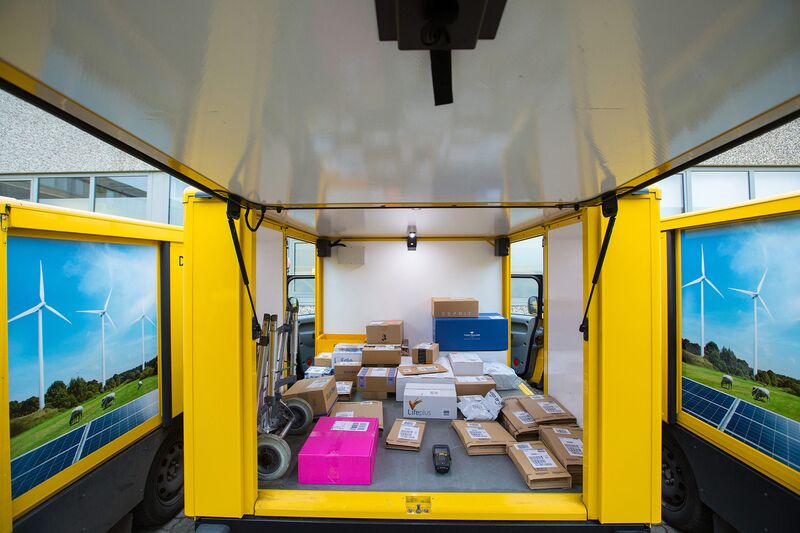This boxy, bare-bones van has no air conditioning or radio, no
passenger seat and a top speed of less than 50 miles an hour. Yet the
electric vehicle’s success has irked the likes of Volkswagen AG.
When Deutsche
Post AG couldn’t find a zero-emission delivery van that met its needs,
it bought a startup and developed one. Now Europe’s largest postal
service may start selling those vehicles — dubbed StreetScooters — to
others, showing the potential for disruption in the rapidly changing
auto market.
“It’s a good example of a startup stimulating competition in the
industry and putting pressure on the established manufacturers,”
said Stefan Bratzel, director of the Center of Automotive Management at
the University of Applied Sciences in Bergisch Gladbach, Germany. The
true test for Deutsche Post's foray into truckmaking will come when VW
and Renault SA respond in coming years with better offerings of their
own, he said.
For now, Deutsche Post is in an enviable position, saying it
breaks even on the venture after just 2,500 units. That stands in
contrast to carmakers from Tesla Inc. to General Motors Co., which lose
money on electric cars despite government incentives.
The mail company plans to churn out 10,000 e-vans annually
starting this year, which would make the StreetScooter the No. 1
electrified light commercial vehicle in Europe, overtaking Renault’s
Kangoo, according to Ian Fletcher, an analyst at research company IHS
Markit. The company can boost output to 15,000.
Talks with
potential customers from “numerous industries” in Germany and abroad are
underway, with one client looking to buy a “very, very large number” of
StreetScooters, said management board member Juergen Gerdes. Deutsche
Post will provide more details by early May, but early indications are
the company has plans beyond mail delivery.
In September, the
Bonn-based company displayed an orange version with an electro-hydraulic
three-way dumper that might suit trash and construction companies. It’s
also working on a larger variant with more cargo room.

Parcels for distribution sit in the back of a StreetScooter.
Photographer: Krisztian Bocsi/Bloomberg
The
vehicle, which carries Deutsche Post’s horn logo, is a symbol of the
European car industry’s inability to come up with quick and
cost-efficient solutions to lower emissions for the last-mile delivery
market and municipal fleets. Cities from Paris to New Delhi to
Stuttgart, home to Daimler and Porsche, are banning some diesel vehicles
or taking other steps to cut emissions.
The mail company plans to electrify its global fleet of
92,000 vans and has already started switching away from diesel. It will
roughly double its German StreetScooter fleet to about 4,000 by year
end, Gerdes said. As battery capabilities improve, the postal company
wants to deploy the van in rural areas as well. It can travel some 50
miles on a charge, about half that of a Renault Kangoo van.
Marcus
Springer, 43, became one of the first StreetScooter drivers in 2013,
when he switched from a VW diesel transporter to an early version of the
e-van in Hamburg. Since the start of 2015, he’s been using the latest
model on his daily 19-kilometer (12 mile) route.
“It’s like
driving an automatic and it accelerates quickly,” said Springer, who
carries a portable radio for entertainment. “When I first got it, my
route slowed down considerably because I constantly had to tell people
about the new van, and they still keep asking me.”

A Deutsche Post employee uses a StreetScooter to make a postal delivery in Hamburg.
Photographer: Krisztian Bocsi/Bloomberg
While the van is a niche product, tailor-made to help Deutsche Post jostle for share in the 70 billion-euro ($76 billion) global last-mile delivery market,
demand may grow. Parcel volumes in countries including Germany and the
U.S. are set to double over the next 10 years, according to McKinsey
& Co. Atlanta-based rival UPS has taken a different tack, choosing
to retrofit its trademark brown vans in Europe by replacing diesel
engines with batteries, a slow process.
When purchasing and
operating costs are taken into account, Deutsche Post has come out ahead
on the StreetScooters, said Chief Executive Officer Frank Appel.
Overall, maintenance costs for e-vehicles are about 35 percent less than
for cars with internal-combustion engines, the German IFA automotive
industry institute estimated.
“It’s extremely annoying to me,”
Volkswagen CEO Matthias Mueller said last August when asked about the
StreetScooter. “I am asking myself why Deutsche Post didn’t work with us
on this,” he said, adding that VW will still try and “get a foot in the
door.”
No comments:
Post a Comment